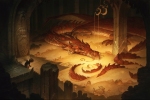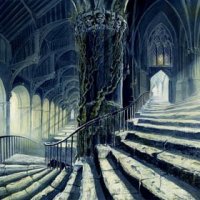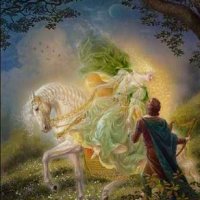The dragon Smaug is in many ways the centrepiece of both The Hobbit book and film series – no other character more often dominates covers, calendars and promotional art related to the story. It is no accident that a dragon plays such a prominent role in one of J R R Tolkien’s very first works of fiction – he did, after all, once famously say: “I desired dragons with a profound desire”. For Tolkien’s taste, however, there were too few dragons in ancient literature, indeed by his count only three – the Miðgarðsorm or ‘Worm of Middle-earth’ which was to destroy the god Thor at Ragnarök, the Norse apocalypse; the dragon which the Anglo-Saxon hero Beowulf fights and kills at the cost of his own life; and Fafnir, who is killed by the Norse hero Sigurd. There are elements of all three of these mythological dragons in Smaug, as well as some entirely of Tolkien’s own making, such as the dragon’s name. Tolkien once noted that Smaug bore as a name the past tense of the primitive Germanic verb smúgan (to squeeze through a hole) – “a low philological jest”, as Tolkien himself put it, from an Oxford professor of Anglo-Saxon and Norse.
Whilst the first dragon referred to above was too enormous and mythological to appear in a story on anything like a human scale, the second appears to be a more plausible prototype for Smaug. Tolkien was of course a prominent critic of and expert on Beowulf – indeed he described the poem as one of his “most valued sources” for The Hobbit. Many of Smaug’s attributes and behaviour in The Hobbit derive directly from the unnamed “old night-scather” in Beowulf: great age; winged, fiery, and reptilian form; a stolen barrow within which he lies on his hoard; disturbance by a theft; and violent airborne revenge on the lands all about. However, although this dragon had some good touches it remained speechless and without marked character. For the most part, then, Tolkien was left with the third dragon, Fafnir. In the Eddic poem Fdfnismdl Sigurd stabs it from underneath, having dug a trench in the path down which it crawls – this is perhaps one of the “stabs and jabs and undercuts” which the dwarves mention while they are discussing “dragon-slayings historical, dubious, and mythical” in chapter 12 – but Fafnir does not die at once. More telling are the following twenty-two stanzas in which the hero and the dragon engage in a conversation, from which Tolkien took several hints.
The first hint is that in the Eddic poem Sigurd, to begin with, will not give his name, but replies riddlingly, calling himself both motherless and fatherless. Tolkien entirely remotivates this, explaining “This of course is the way to talk to dragons…No dragon can resist the fascination of riddling talk”. Sigurd’s motive was that Fafnir was dying, and it was the belief in old times that the word of a dying man had great power, if he cursed his enemy by name. Tolkien took a second hint from Fafnir’s wily and successful attempt to sow discord between his killers, for Fafnir gives Sigurd unsought advice that his ally Regin will betray him. In the same way Smaug tells Bilbo to beware of the dwarves, and Bilbo (with less reason than Sigurd) is for a moment taken in. There is a third hint after the dragon is dead, for Sigurd, tasting the dragon’s blood, becomes able to understand bird-speech, and hears what the nut-hatches are saying: that Regin does indeed mean to betray him. In The Hobbit, of course, it is the thrush who proves able to understand human speech, not the other way round, and his intervention is fatal to the dragon, not the dwarves.
At any rate Tolkien was certainly well aware of the one famous human-dragon conversation in ancient literature, and seems to have admired the sense it created of a cold, wily, superhuman intelligence (or ‘overwhelming personality’, as Tolkien’s himself once put it). What he did so cleverly was to take the hints above and in many ways improve upon them. Much of the improvement comes from a kind of anachronism, which as so often in The Hobbit creates two entirely different verbal styles. Smaug does not, initially, talk like Beorn, or Thorin, or Thranduil the elf-king, or other characters from the heart of the heroic world. He talks like a twentieth-century Englishman, but one very definitely from the upper class, not the bourgeoisie at all. His main verbal characteristic is a kind of elaborate politeness, even circumlocution, of course totally insincere (as is perhaps so often the case when one is confronted with the English upper-class!) but insidious and hard to counter. “You seem familiar with my name”, says Smaug, with a hint of asperity – after all, being ‘familiar’ is low-class behaviour, like calling people by their first names on first meeting – “but I don’t seem to remember smelling you before”. This is nothing like Fafnir, or Sigurð, or indeed any character from epic or saga, but it is convincingly dragon-like nonetheless: threatening, cold, and horribly plausible.
Getting rid of Smaug remained, perhaps, Tolkien’s major plotting problem in The Hobbit, and here his ancient sources were not much use to him. Thor’s son Viðar kills the Miðgarðsorm by putting one foot on its lower jaw, seizing the upper jaw, and tearing it in half. There seemed no likelihood of anyone in Middle-earth following suit. Beowulf’s self-sacrificing victory and death, meanwhile, would involve creating a ‘warrior’, a character undeniably and full-time heroic, difficult to fit into what was still essentially a children’s novel. Tolkien solved his problem by creating the character of Bard, who in some ways resembled a figure from the ancient world of heroes. The Bowman prides himself on his descent from Girion, Lord of Dale. He re-establishes monarchy in Laketown, which till then seems to have been a kind of commercial city-state. The proof of Bard’s descent lies in an inherited weapon, a black arrow, which he speaks to as if it were sentient, and as if it too wanted vengeance on its old master’s bane. It is this arrow, of course – shot by Bard, but directed by the thrush, and ultimately by Bilbo – which kills the dragon, in a way not entirely dissimilar to Sigurd or Beowulf. In a manner entirely suited to the world of heroic myth, victory over the dragon in the end turns on a single man and an ancestral weapon.
Interestingly, the various depictions of Smaug in motion pictures have not departed significantly from the original text of The Hobbit, so evocative and memorable was Tolkien’s description of the dragon. For instance, in the 1977 animated version of the novel, Smaug’s design is in general consistent with Tolkien’s description (save for his oddly lion-like face). He is, however, accurately portrayed by showing lights shining forth from his eyes whenever he is searching for something – in the novel this effect was described by Tolkien as “a sudden thin and piercing ray of red from under the drooping lid of Smaug’s left eye”. In Peter Jackson’s live action adaptation, meanwhile, Smaug is presented as a fairly typical fantasy dragon, with a long head, red-gold scales, wyvern-like body and piercing yellow-red eyes. However, very much in keeping with the conversation between Smaug and Bilbo in the novel, the dragon speaks in the stentorian tones of an upper-class Englishman, with an underlying growl from the classically trained British actor Benedict Cumberbatch. For me this just goes to show what a superb, original and captivating creation Smaug was – not only a distillation of the mythological dragons which had come before him but the archetype for all the fantasy dragons that were to come afterwards.














Smaug having a weak spot on his underbelly is sort of like Beowulf’s slaying the dragon from beneath, but that it’s only one tiny spot is more akin to Achilles’ heel.
Having recently seen the last installment of Peter Jackson’s Hobbit, his creation of Smaug is fresh in my mind. Thanks for this thorough-going treatment of Tolkien’s sources for the dragon.
Reblogged this on marieowyn and commented:
lovely piece on Smaug
Reblogged this on The Wizard's Sword and commented:
Got to love dragons. An enlightening look at Tolkien’s Smaug.
This was so interesting to read. I love dragons (I have ever since I was a child), and I love, love LOVE mythology. Thank you for talking about this and going into so much depth, and for portraying it in such an approachable and interesting way 🙂
And by the way, you have gained a follower!
Thanks for the follow!